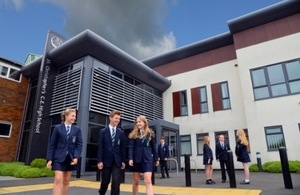School lights up efficiency savings with capital investment
St Christopher’s CE High School in Lancashire plans significant savings on its energy bills after investing £15,000 in new LED lighting.

Investment could reduce the school’s energy bill by over £60,000 over the next 5 years.
Accrington St Christopher’s CE High School in Accrington is a successful and popular 11-18 single academy trust with over 1,300 pupils and students. It is planning significant revenue savings on its energy bills after investing £15,000 in new LED lighting across the school.
After the installation, the school estimates that it will cut its yearly energy bill from just over £22,000 to about £10,000. This will free up funds to support educational outcomes. As the LEDs come with a 5-year warranty, the £15,000 investment is expected to reduce the school’s energy bill by over £60,000 over the next 5 years.
According to the school’s project manager, Peter Crewe, the focus on new lighting was an obvious thing to do: “We asked a number of companies to investigate our energy use and it became clear that replacing the lighting would make a considerable financial saving. Most companies are happy to investigate energy use at no cost, and I would recommend using 2 or 3 companies so you can compare figures. Replacing the lighting will also save our site supervisors’ time and reduce our carbon footprint by 50.5 tonnes per year. This is an important factor for us as a Green Flag Eco-school.”
The over-subscribed school, which rents out its sports facilities out of school hours, recognises the need for schools to continuously review their expenditure. Although the sports hall generates income, it also uses a lot of energy because of the length of time it is lit. Cleaners start at 6am and the room is in constant use during the day. Different groups then use the sports hall between 5.30pm and 9.30pm on week days and at weekends. As a result, installing LED lighting in this room alone will save £1,600 every year.
The school also has to consider the impact that old lighting has on the children’s learning environment. Dating back to 1958, replacing flickering and broken fluorescent tubes is getting more difficult and requires considerable staff time. Old-fashioned lighting can also negatively impact on children’s and staff health. High energy bills ultimately use up finances that could be better spent on ICT equipment or new text books.
Mr Crewe adds: “We constantly review our financial position and multi-year budget planning helps us to identify projects where we can make savings and where investment is worthwhile.”
If you would like to find out more, you can contact Peter Crewe.